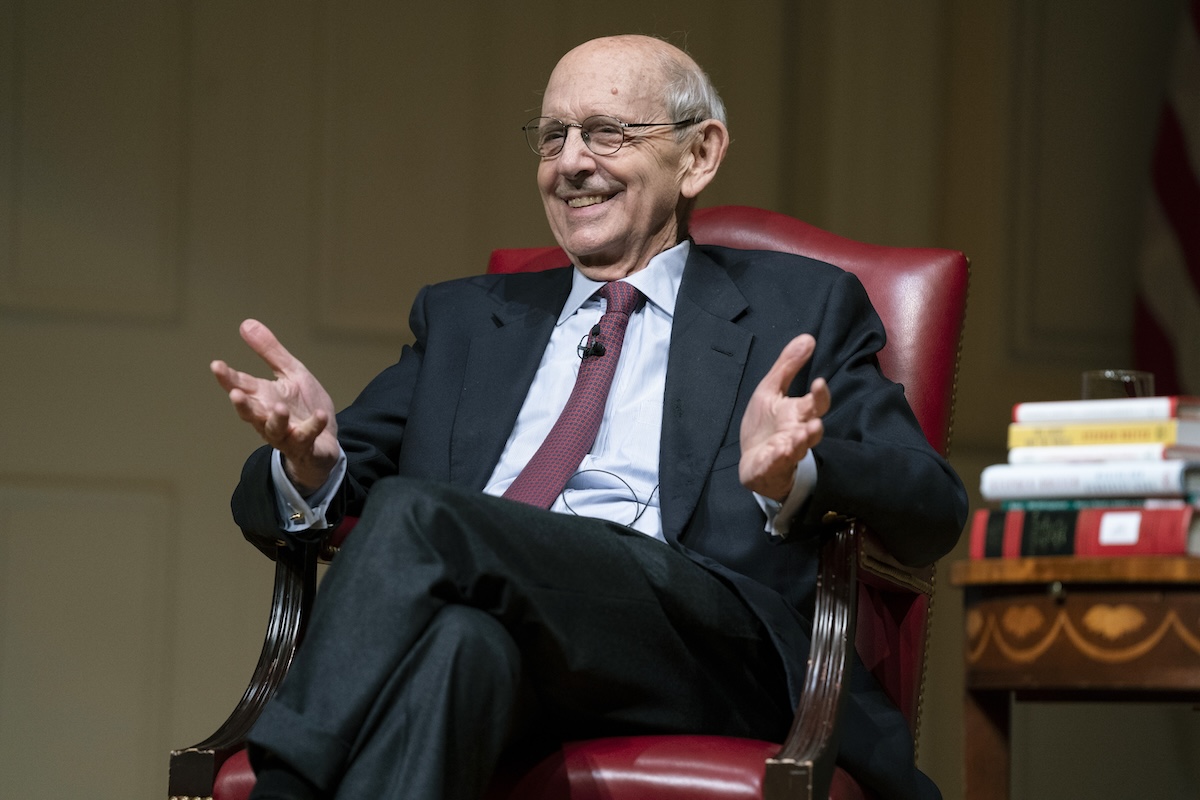Zack Fontenot was a menace. In fact, had we both been alive in 1904, he is the last person I would have wanted anywhere near my merry-go-round because he had a history of setting them on fire. He was arrested, tried, and convicted of arson for burning Alexander Hardesty’s merry-go-round, but the Louisiana Supreme Court set him free. Why? In 1904 it simply was not a crime in the state to burn someone else’s merry-go-round. Had it been a railroad car or a “heap of hay” or “coal in a coal boat,” the authorities would have had him dead to rights, and he would have languished for several years in the state penitentiary. Because it was a merry-go-round, however, Zack Fontenot was released upon the good people of St. Landry Parish to burn more merry-go-rounds with impunity.
Zack Fontenot was fortunate that former U.S. Supreme Court associate justice Stephen Breyer, still 34 years from being born, didn’t sit on the Louisiana Supreme Court in 1904. According to Reading the Constitution: Why I Chose Pragmatism, Not Textualism, Justice Breyer’s latest book, he would have looked at the state statute defining arson, noted that “merry-go-round” was not on the discrete list of things the legislature protected from arsonists on pain of criminal conviction, and then completely ignored the statute and judicially created a crime ex post facto—and locked up Zack Fontenot for an act that was not illegal when he committed it.
Does common sense tell you that burning a merry-go-round that belongs to someone else should be a crime? Of course, it does. But the rule of law requires that every citizen be able to read the law and determine whether his or her behavior is lawful. What precipitated Zack Fontenot’s attack on Alexander Hardesty’s merry-go-round is lost to the ages, but had Fontenot been a calculating and careful citizen, he should have been able to read the statute and determine with reasonable certainty what he could burn and what to avoid burning if he wanted to stay out of jail.
Justice Breyer’s approach to the law prioritizes the aim of the law. What does the law intend to accomplish? According to Breyer, the law—whether a statute or the Constitution—should be interpreted with that aim in mind. Judges should compensate for the oversight, imprecision, and miscalculation of the legislature by rewriting or reinterpreting the words of the text—“imaginative reconstruction,” as Judge Learned Hand described it. His advice for interpreting the Constitution is even worse—“because values predominate [in Constitutional interpretation], one’s heart plays a bigger role [than one’s head].” In that case, it isn’t just Zack Fontenot (who probably belongs in jail anyway) whose freedom is in jeopardy. Constitutional interpretation represents the resolution of questions related to the most basic ways our system of government works and can turn on the subjective whims of a single unelected and unaccountable judge. Our constitutional history has far too many examples of just this phenomenon.
I was a law student when Samuel Alito was elevated to the Supreme Court, and I remember being completely surprised that one of my very progressive but very accomplished professors was genuinely enthusiastic about the appointment. Alito has proved to be a justice who represents everything that that professor would oppose socially, politically, and jurisprudentially. He was enthusiastic, however, because he knew that Alito would be clear thinking and consistent in his judicial opinion writing. It turns out that he was not a fan of certain progressive members of the Court, even though they reached exactly the conclusions he would support, because they reached them in incoherent and imprecise ways. This book, which has few virtues, demonstrates that Breyer falls into this latter category. In fact, it is alarming to get this glimpse of the mind of someone who sat for so long on our nation’s highest court only to find such a vapid, contradictory, and unserious approach to the judicial craft.
Breyer begins the book by contrasting his pragmatic approach to the law with the textualist and originalist view of the law embodied by jurists like Samuel Alito, Clarence Thomas, and the late Antonin Scalia. In doing so, however, he creates a strawman of the originalist position and misrepresents the historical provenance of his own approach. First, there is no originalist who would not employ the interpretative tools that Breyer names as belonging exclusively to the pragmatist—text, history, values, consequences, legislative purposes, among others. The difference is that Breyer claims that “aside from first reading the text itself, there is no specified rank order among these tools.” Justice Scalia actually co-wrote more than 500 pages explaining the value of these tools and laying out a systematic, predictable approach to using them in Reading Law: The Interpretation of Legal Texts.
Second, Breyer consistently returns to his concern for a “workable democracy.” Judges have an almost holy obligation in his mind to engage in “judicial gap-filling” to make sure that our democracy remains vibrant and intact. There are two primary problems with this assertion.
The first problem is that it reveals a profound judicial arrogance. The justices sitting on the Louisiana Supreme Court in 1904 likely had no doubt that any given legislator in Louisiana believed they had passed a law that criminalized setting fire even to merry-go-rounds. But the legislature did not actually write it in the law. Opening the door to “judicial gap-filling” or “imaginative reconstruction” in small or even obvious things sets a precedent for doing the same in large and more contested things. The Constitution exclusively vests the legislative authority of the United States in the Congress, and the Supreme Court is not the Congress or a congressional adjunct. What did the Louisiana legislature do? The statute was rewritten, and to the relief of carnival operators throughout the state, the law now protects merry-go-rounds. Congress has acted before to change or clarify laws in response to gaps and inconsistencies uncovered under judicial scrutiny, and this is precisely how to make our democracy “workable.”
Further, Breyer has no concern for the rule of law. In fact, the few times that the term does appear he is undermining the larger arguments of the book. Breyer rightly observes that too much fluidity in the law creates uncertainty and undermines the rule of law, but he posits this as a reason to reject overturning even “egregiously wrong” precedent in respect of stare decisis, the legal doctrine that inclines courts “to stand by things decided.” Overturning bad precedent provides a corrective to the law, but judges acting as self-appointed super legislators with almost mystical access to the mind of the “reasonable legislator,” a key component of Breyer’s approach to statutory interpretation, does nothing but destabilize it.
The rule of law requires consistency and predictability. Zack Fontenot deserved the opportunity to assess the legal risks of burning someone’s merry-go-round, and business owners, taxpayers, and parents must be able to read the law and understand with fair certainty what is required of them, prohibited to them, or due them. At the point that judges can shift these things and undermine that surety, the law will cease to matter, since no one will know what it is until five of nine unelected lawyers have the final say.
It may be inefficient and anticlimactic, even, for litigants to battle in court for years only to have a court decide that the law is void for vagueness or otherwise lacking in enough clarity and coherence for a court to decipher and apply. At that point, the only remedy is legislative action to correct the defect, which can take even more time. But democraticinstitutions are inherently inefficient, and this is a good thing. (Note that bureaucratic inefficiency is a qualitatively different issue.) Democratic institutions, especially in a system with separation of powers, impede the tyranny of a single person or of a majority. They require cooperation, compromise, and patience. Unauthorized “imaginative reconstruction” subverts that inefficiency by creating judicial remedies when legislative remedies are required. Breyer’s affable, friendly argument for pragmatism is a dangerous conduit for judicial tyranny.
I do recognize that Breyer makes a distinction between statutory and constitutional interpretation in Reading the Constitution, and to this point I have conflated some of his arguments. But this conflation is of two things that represent a distinction without a difference. But there are some troubling arguments that he makes about each of these judicial undertakings that are uniquely problematic as applied to the interpretation of one type of law versus the other.
Regarding statutory interpretation, Breyer helpfully articulates the three “general features” of his purpose-based approach. They are: (a) consistency with the “common law mode of judging,” (b) accounting for how the law impacts other legal rules and principles, and (c) the consideration of a theoretical “reasonable legislator.” But he never demonstrates how these are helpful. He attempts at several points to appeal to the common law tradition and even refers to his approach as “traditional” but cherry-picks Aquinas and Blackstone while reducing the concept of “common law” not to what it would have meant to Blackstone but to the concept of “judge-made” positive law as understood by recent legal theorists like Oliver Wendell Holmes. He doesn’t seem to recognize that policy considerations involved in how a law might impact other legal principles is the job of Congress. And it is impossible to know whether this “reasonable legislator” voted for or against a piece of legislation. Was he or she former Louisiana state representative and KKK member David Duke, disgraced former New York representative George Santos, or celebrity representative Alexandria Ocasio-Cortez? Moreover, legislatures pass laws as a single legislature rather than as individual legislators, in a process that is complex and layered. So even if the mind of the “reasonable legislator” is identifiable and accessible, it would be as relevant to what the law means as the recipes on a random page of a Betty Crocker cookbook.
As to Justice Breyer’s approach to the Constitution, it is good to remember the comments of the late Antonin Scalia at the 1997 Acton Dinner: “People ask me, ‘When did you become a textualist? What caused you to become a textualist?’ as if it is some weird thing … you have a text; you should read the text.” The natural, default approach to understanding any written text—legal or otherwise—is to read the words on the page and not attempt to peer behind or between the words to undermine the intent. Breyer represents a counterintuitive trend that is dismissive of the constitutional text and creates a plastic document with a fluid meaning. It requires an approach to reading that, as he describes it, consciously leaves behind the head in favor of the heart. This results in an anachronistic understanding of words and phrases that have been subjected to the modern sentimentality of judges.
Whether the text is a statute or the Constitution, the only way to preserve the consistency and predictability required by the rule of law is to interpret it according to established canons of interpretation. These canons should be external even to each institution and be the agreed upon rules that Congress knows will be applied by the courts, and the courts in turn know that Congress gave consideration to and deliberated the legislation before it became law. Without clarity, consistency, and predictability, the law can easily become both onerous and unstable—and a tool for tyranny.
Reading the Constitution is not only unconvincing; it’s not even interesting or particularly erudite. Justice Breyer has only laid bare the utter intellectual bankruptcy of his approach to the law. We can only hope that fewer judges will find this approach attractive and just “read the text,” as Justice Scalia would implore them to do.

